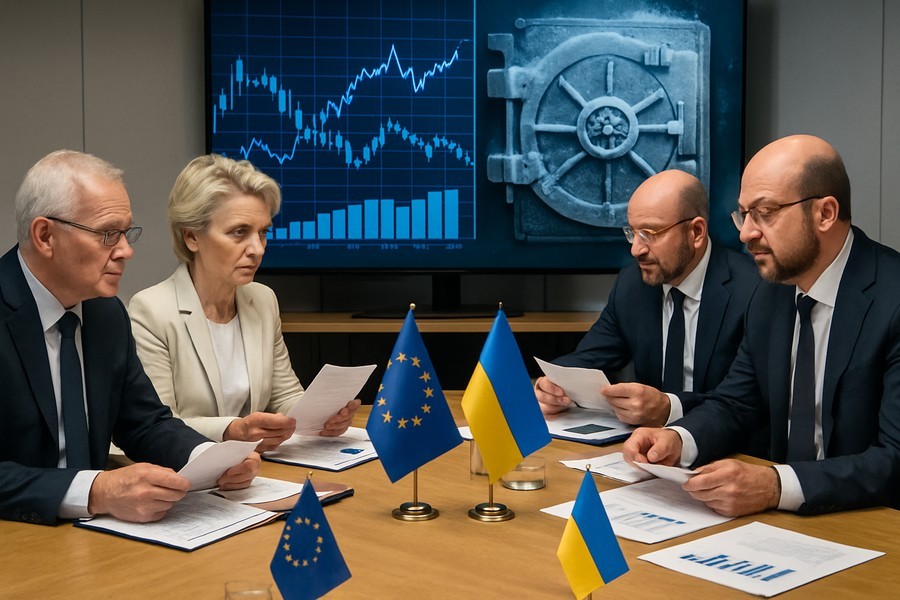
European Leaders to Discuss Directing Frozen Russian Assets to Assist Ukraine
European leaders are considering a unique plan to channel frozen Russian assets to financially support Ukraine. The contentious plan, termed a "reparations loan," could result in Ukraine receiving approximately €140bn worth of Russian assets currently held in a Belgian financial institution.
The initiative has been under development for several months, mainly due to legal intricacies and concerns about global financial stability. Some nations, including Belgium, have been hesitant to back the idea due to potential legal implications should Russia contest the decision.
The Russian response to the idea of Europe using its money has been highly negative. A representative warned that any asset seizure would result in a significant backlash.
Unpacking the Reparations Loan Concept
With dwindling US support for Ukraine, European Union (EU) member states have sought ways to continue aiding Ukraine in its ongoing conflict with Russia. Collectively, member states have already provided about €177.5bn in financial aid to Ukraine. However, with no ceasefire in sight, Ukraine will require more financial assistance as the war enters its fifth year.
The cost of Ukraine's reconstruction and recovery is estimated to be more than $486bn, according to United Nations and World Bank calculations. Around €210bn in Russian investments were frozen by the EU when Russia initiated a full-scale invasion. A significant chunk of these frozen assets, about €185bn, is held by a financial transactions clearing house located in Belgium.
When these Russian investments were initially frozen, most were in the form of sovereign bonds, loans made to governments that are paid back over time. These bonds have since matured, but due to the sanctions imposed in 2022, Russia cannot access this money.
The EU has been using the interest accrued from these frozen Russian assets to support Ukraine's defense efforts, amounting to up to €3bn annually. Now, the EU is contemplating redirecting the frozen funds themselves to Ukraine as a no-interest "reparations loan". The funds would be available immediately, with the understanding that Ukraine would repay it through reparations from Russia once the war concludes.
Legal Hurdles and Potential Solutions
International law dictates that sovereign assets cannot be directly appropriated. Although these assets are frozen, they remain Russia's property, making their seizure a legal challenge. To navigate this, the EU could "borrow" Russia's frozen funds and replace them with a debt instrument, guaranteed by all member states.
This strategy could also assuage the financial institution's concerns about how to repay Russia, should the war end unexpectedly and Russia demand its assets back. While some nations have expressed their reservations about the plan, they are open to it if there is assurance that the risk will be borne collectively.
Despite the EU's attempts to navigate the legal challenges, Russia fiercely opposes the idea of its investments being used in this manner. A Russian official characterized the move as the "theft of the century" and warned of severe repercussions and potential harm to Western financial stability.
Support and Opposition for the Plan
Several European countries, including Poland and the Scandinavian and Baltic countries, fully support the plan. However, leaders who are more sympathetic towards Russia, such as those in Hungary and Slovakia, may resist it.
One major concern is the potential fallout if Russia retaliated against companies in their countries, making it difficult to justify the asset seizure to their citizens. Despite these reservations, it has been suggested that the plan could be adopted by a large majority, bypassing any individual veto.
Another point of contention is how Ukraine would be allowed to utilize the funds. Some countries would like the funds to be used to support Ukraine's budget, while others want the funds reserved for purchasing European military equipment. Ukraine, however, is resisting any limitations on the usage of the funds.
A high-ranking legal advisor in the Ukrainian administration emphasized that the victim, not the donors or partners, should decide how to address its most urgent defense, recovery, and compensation needs. She added that some funds would have to be allocated to other sectors such as reconstruction and victim compensation.
